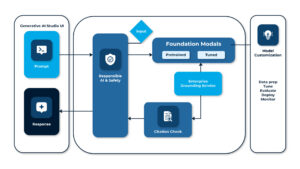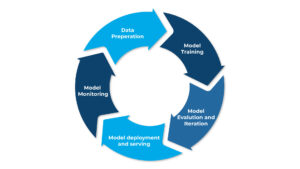Introduction to Vertex AI
Vertex AI is at the core of machine learning (ML) platforms, providing a versatile suite that not only enables seamless training and deployment of ML models but also allows customers to customize large language models (LLMs) for integration into AI-powered applications. It develops a uniform platform that supports team collaboration by combining data engineering, data science, and ML engineering procedures. This convergence on a single toolset facilitates collaboration between data scientists, engineers, and developers to develop and scale AI applications. By leveraging the extensive capabilities of Google Cloud, Vertex AI allows enterprises to handle the complexity of ML with ease and scale their applications to new heights.
Key Features of Vertex AI
AutoML: Vertex AI’s AutoML represents a significant approach to machine learning by automating key portions of the model creation process. This unique feature enables anyone, even those with less machine learning skills to easily construct and deploy high-quality models. Vertex AI’s AutoML automates operations like feature engineering, hyper-parameter modification, and model selection, making the complicated ML pipeline more approachable. Users may drastically minimize the time and resources needed for model construction by employing automated workflows, allowing professionals to harness the potential of machine learning and deliver insights from their data.
Custom Training: Vertex AI offers a managed training service that enables large-scale model training to be operationalized. It can be used to run training apps on Google Cloud infrastructure that are based on machine learning (ML) framework. Vertex AI provides integrated support for the below ML frameworks, simplifying the model training and serving processes.
- PyTorch
- Tensorflow
- Scikit-learn
- XGBoost
Model Garden: It is a machine learning model library in the Google Cloud console that allows you to explore, test, customize, and deploy Google proprietary and selected open source models and components.
Generative AI: Generative AI on Vertex AI (also known as GenAI) provides access to Google’s huge generative AI models for testing, tuning, and deploying in your AI-powered applications. This page provides an overview of Vertex AI’s generative AI workflow, the features and models available, and links to resources for getting started.
Generative AI Workflow

Use Vertex AI’s end-to-end MLOps tools to automate and expand projects across the ML life cycle once you’ve deployed your models. These MLOps solutions run on a fully managed infrastructure, which can be tailored to your specific performance and budget needs.
Understanding the Vertex AI Integration in the Machine Learning (ML) Workflow
This section provides overview of machine learning approach and how Vertex AI can help you construct and deploy models.
Machine Learning Workflow:

Data Preparation: Perform exploratory data analysis (EDA) after cleaning the dataset to understand its format and properties. Apply the appropriate transformations to spilt the data into training, validation, and test sets. Use Vertex AI Workbench notebooks for data exploration and visualization. Utilize DataProc serverless Spark via Vertex AI Workbench for efficient processing of huge datasets without the need to manage dedicated clusters.
Model Training: For model performance adjustment, choose between AutoML and custom training approaches. Without coding, AutoML provides tabular, image, text, and video data. Custom training with Vertex AI Vizier optimizes hyper-parameters, while Vertex AI experiments allow for ML strategy comparison. Finally, use the Vertex AI Model Registry to register and deploy models for versioning and production.
Model Deployment: Deploy your custom-trained model for real-time online predictions using pre-built or custom containers, while optimizing for cost and latency with TensorFlow runtime. Use the Vertex AI Feature Store to centrally serve features and track their health in tabular models. Vertex Explainable AI assists in recognizing mislabeled data and analyzing feature contributions.
Model Monitoring: Model Monitoring allows you to track performance indicators, detect skew and drift in predictions, and receive notifications for substantial deviations from your deployed model. Retrain your model with real-world data to maintain high accuracy, and use Vertex AI’s automatic monitoring for proactive model maintenance, assuring responsiveness to changing data patterns in commercial applications.
Conclusion
Google Cloud’s Vertex AI is an excellent machine learning platform that accelerates the entire training and deployment process for large language models. Its primary features, including AutoML, Custom Training, Model Garden, and Generative AI emphasize the company’s dedication to automating ML activities, democratizing access, and seamlessly integrating with Google Cloud’s wide capabilities. MLOps technologies on the platform allow full automation and scalability throughout the machine learning life cycle, transforming it into an AI innovation accelerator.





